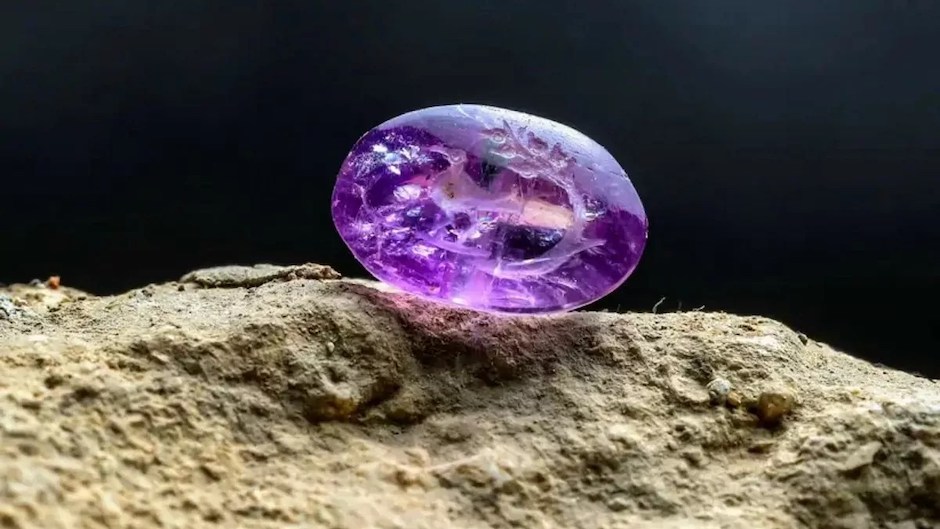It was discovered in Israel, near the site of the Temple in the time of Jesus. Experts said the engraving had never been found on other objects until now.
 Experts found that the stone is probably the first-ever known image of the balm of Gilead, mentioned in the Bible. / IAA.
Experts found that the stone is probably the first-ever known image of the balm of Gilead, mentioned in the Bible. / IAA.
Archaeologists of the Israel Antiquities Authority (IAA) and the Israel Nature and Parks Authority (INPA) have found an engraved lilac amethyst, sifting through soil dug during an archaeological excavation.
The little artifact was retrieved in the road that 2,000 years ago connected the Shiloah Pool at the outskirts of Jerusalem with the Temple Mount.
It may have belonged to a Jew, possibly a pilgrim, that walked on that area in the last decades before the destruction of the Second Temple, wearing a delicate ring bearing an engraved lilac amethyst stone. The ring might broke, the stone slipped on the floor and then into the underground drainage channel.
The elongated branch with five fruits engraved in the stone caught the attention of experts, because it appeared to be something different from any other species ever found portrayed on seals from the time. It also features a bird, probably a dove.
Experts found that the stone is probably the first-ever known image of the balm of Gilead, mentioned in the Bible, as well as in later Jewish and historical sources, as the City of David, the Antiquities Authority and the Israel Nature and Parks Authority (INPA) said Thursday in a joint statement.
Prof. Shua Amorai-Stark, an expert in engraved gems, explained that “toward the end of the Second Temple period, the use of stone stamps expanded and became more common, but in most stamps discovered so far with plant engravings, it is common to find plants that were common in Israel at the time: vines, dates and olives, which are among the seven species”.
However, “on this stone seal, we immediately noticed that the fruit that appears on it is unlike any of the fruits we have encountered to date”, he added.
“This is an important find because it may be the first time a seal has been discovered in the entire world with an engraving of the precious and famous plant, which until now we could only read about in historical descriptions”, said archaeologist Eli Shukron, who conducted the excavation at the foundations of the Western Wall on behalf of the IAA and the City of David.
The so-called 'balm of Gilead' was an aromatic resin or spice used to produce perfumes, incense and medicines. The bush that produced the resin from which the balm was prepared grew so abundantly in Gilead in Old Testament times that it came to be known as 'balm of Gilead'.
It was known as tzari in Hebrew or balm tree (nataf); or later in the Mishnah period "persimmon". Its modern scientific name is commiphora gileadensis. This "biblical persimmon" plant is not related to the orange-coloured persimmon fruit common in our days.
The plant's name is mentioned in Genesis, when Jacob's sons sit down to eat after throwing their brother Joseph into a well, deciding to sell him into slavery in the account in Genesis 37:25: As they sat down to eat their meal, they looked up and saw a caravan of Ishmaelites coming from Gilead. Their camels were loaded with spices, balm and myrrh, and they were on their way to take them down to Egypt.
Later, in Exodus, the same word for the species is included in the incense ingredients: “Then the Lord said to Moses, Take fragrant spices—gum resin, onycha and galbanum—and pure frankincense, all in equal amounts, and make a fragrant blend of incense, the work of a perfumer. It is to be salted and pure and sacred”.
It was also known that the balm of Gilead was a component of the favourite perfume of the legendary queen of Egypt, Cleopatra.
It is also mentioned in the prophet Jeremiah (8:22: "Is there no balm in Gilead?"; and 46:11: "Go up to Gilead and get balm").
The balm was one of the ingredients used for making the Temple incense during the Second Temple period, which is when this seal was made”, pointed out Shukron.

Las opiniones vertidas por nuestros colaboradores se realizan a nivel personal, pudiendo coincidir o no con la postura de la dirección de Protestante Digital.
Si quieres comentar o